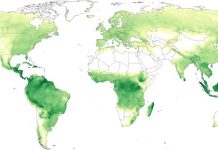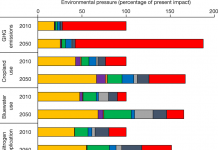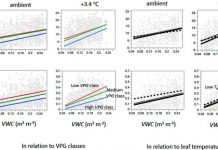【中国草原碳储量的时空动态模拟】ZHANG Li ZHOU GuangSheng JI YuHe BAI YongFei. Spatiotemporal dynamic simulation of grassland carbon storage in China. SCIENCE CHINA Earth Sciences 59(10) 1946-1958 (2016)
Based on the Terrestrial Ecosystem Model (TEM 5.0) together with the data of climate (temperature precipitation and solar radiation) and environment (grassland vegetation types soil texture altitude longitude and latitude and atmospheric CO2 concentration data) the spatiotemporal variations of carbon storage and density and their controlling factors were discussed in this paper. The results indicated that: (1) the total carbon storage of China’s grasslands with a total area of 394.93×104 km2 was 59.47 Pg C. Among them there were 3.15 Pg C in vegetation and 56.32 Pg C in soil carbon. China’s grasslands covering 7.0–11.3% of the total world’s grassland area had 1.3–11.3% of the vegetation carbon and 9.7–22.5% of the soil carbon in the world grasslands. The total carbon storage increased from 59.13 to 60.16 Pg C during 1961–2013 with an increasing rate of 19.4 Tg C yr-1. (2) The grasslands in the Qinghai-Tibetan Plateau contributed most to the total carbon storage during 1961–2013 accounting for 63.2% of the total grassland carbon storage followed by Xinjiang grasslands (15.8%) and Inner Mongolia grasslands (11.1%). (3) The vegetation carbon storage showed an increasing trend with the average annual growth rate of 9.62 Tg C yr-1 during 1961–2013 and temperature was the main determinant factor explaining approximately 85% of its variation. The vegetation carbon storage showed an increasing trend in most grassland regions however a decreasing trend in the central grassland in the southern China the western and central parts of the Inner Mongolian grasslands as well as some parts on the Qinghai-Tibetan Plateau. The soil carbon storage showed a significantly increasing trend with a rate of 7.96 Tg C yr-1 which resulted from the interaction of more precipitation and low temperature in the 1980s and 1990s. Among them precipitation was the main determinant factor of increasing soil carbon increases of China’s grasslands.
【基流硝态氮输出对面源污染的贡献】HE ShengJia LU Jun. Contribution of baseflow nitrate export to non-point source pollution. SCIENCE CHINA Earth Sciences 59(10) 1912-1929 (2016)
As a common pollutant of nitrogen in groundwater nitrate contamination has become a major concern worldwide. Baseflow one of the dominant hydrological pathways for nitrate migration to streamflow has been confirmed as a leading nitrate source for stream water where groundwater or subsurface flow contaminated heavily by nitrate. That is sufficient improvements of water quality may not be attained without proper management for baseflow even if non-point sources (NPS) pollutants discharged through surface runoff are being well managed. This article reviews the primary nitrate sources the main factors affecting its transport and the methodologies for baseflow nitrate estimation to give some recommendations for future works including: (1) giving sufficient consideration for the effects of climatological morphological and geological factors on baseflow recessions to obtain more reliable and accurate baseflow separation; (2) trying to solve calibration and validation problems for baseflow loads determining in storm flow period; (3) developing a simple and convenient algorithm with







